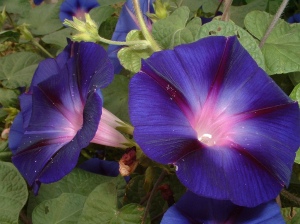 Caution: This plant is not intended for human or animal consumption”.
Caution: This plant is not intended for human or animal consumption”.
The country of origin of the majority and most important of the so-called “magic” hallucinogenic drugs, is Central America. Magic drugs were already of great importance in the old Indian cultures of Mexico. The Spanish chroniclers and naturalists who came to the country soon after the conquest of Mexico by Cortez mentioned in their writings a great number of plants with intoxicating, stimulating, or narcotic effects; these plants were unknown in the Old World and were used by the Indians both in their medical practices and in their religious ceremonies. The cultic use and divine worship given to many of these drugs met with the disapproval of the Christian missionaries, who attempted by any means possible to liberate the Indians from this devilry. They were, however, only partially successful in this respect. The native population secretly continued using the drugs considered by them as holy even after having been converted to Christianity. Although the hallucinogens had long been known in the form of the ancient magic plants and fungi, it was not until their active principles had been isolated and prepared as pure chemical compounds, that they were amenable to scientific study and systematic use in medicine. The most thoroughly investigated hallucinogens are mescaline, LSD, which may be regarded as an improved modification of the active principle of ololiuqui, and psilocybin.
 Ipomoea violacea is native to the New World tropics, and contain a naturally occurring indole called Lysergic Acid Amide (LSA). Morning Glory Seeds called tlitlitzin were used ritually by the Aztec for their psychoactive properties to communicate with the Sun Gods. Their use has continued in southern Mexico, although it wasn’t until about 1900 that tlitlitzin was identified botanically as Morning Glory. A range of wild and cultivated vines in the Morning Glory Family can be found in all vegetation regions throughout modern Mexico. The number of species within the genus Ipomea is believed to be over 500, but the one most widely regarded for its spiritual properties is the Ipomea violacea (often referred to as Ipomea tricolor) species, the strain known as tlililtzin by the Aztecs and employed in their ancient rituals during Pre-Hispanic times. Pedro Ponce de Leon, the Spanish Benedictine monk famous for his work with the deaf, chronicled his findings of the effects of Morning Glory seeds, or tlililtzin, through his observations of the Aztecs’ Shamanic rituals: “Some say little black men appear before them and which tell them what they want to know about. Others say that our Lord appears before them, while still others say that it is angels. And when they do this, they enter a room, close themselves in, and have someone watch so that they can hear what they say.”
Ipomoea violacea is native to the New World tropics, and contain a naturally occurring indole called Lysergic Acid Amide (LSA). Morning Glory Seeds called tlitlitzin were used ritually by the Aztec for their psychoactive properties to communicate with the Sun Gods. Their use has continued in southern Mexico, although it wasn’t until about 1900 that tlitlitzin was identified botanically as Morning Glory. A range of wild and cultivated vines in the Morning Glory Family can be found in all vegetation regions throughout modern Mexico. The number of species within the genus Ipomea is believed to be over 500, but the one most widely regarded for its spiritual properties is the Ipomea violacea (often referred to as Ipomea tricolor) species, the strain known as tlililtzin by the Aztecs and employed in their ancient rituals during Pre-Hispanic times. Pedro Ponce de Leon, the Spanish Benedictine monk famous for his work with the deaf, chronicled his findings of the effects of Morning Glory seeds, or tlililtzin, through his observations of the Aztecs’ Shamanic rituals: “Some say little black men appear before them and which tell them what they want to know about. Others say that our Lord appears before them, while still others say that it is angels. And when they do this, they enter a room, close themselves in, and have someone watch so that they can hear what they say.”
 The flowers of Ipomoea violacea have a trumpet-like shape and various colors, including white, red, purple and blue. The leaves are heart-shaped, with the nearly equal length and width of 8-16 cm. They are attached by a thin, about 10 cm long petiole to a fleshy, hairless stem. Flowers are usually solitary and about 10 cm long. The peduncle is 0.7-7 cm long the pedicels is 1.5-3 cm long. The seed capsule is 2-3 cm long, oval-shaped and is two-celled. It opens up into four valves, releasing four pubescent, elongated, edgy black seeds, about 1 cm long. The seeds have a narrow ridge and 3-6 mm long hair. The plant requires much light, water and a warm climate. The seeds develop in May and germinate within 6-14 days after sowing; the optimal temperature for germination is 18 °C. The flowering season is from July to October.
The flowers of Ipomoea violacea have a trumpet-like shape and various colors, including white, red, purple and blue. The leaves are heart-shaped, with the nearly equal length and width of 8-16 cm. They are attached by a thin, about 10 cm long petiole to a fleshy, hairless stem. Flowers are usually solitary and about 10 cm long. The peduncle is 0.7-7 cm long the pedicels is 1.5-3 cm long. The seed capsule is 2-3 cm long, oval-shaped and is two-celled. It opens up into four valves, releasing four pubescent, elongated, edgy black seeds, about 1 cm long. The seeds have a narrow ridge and 3-6 mm long hair. The plant requires much light, water and a warm climate. The seeds develop in May and germinate within 6-14 days after sowing; the optimal temperature for germination is 18 °C. The flowering season is from July to October.
Morning glory seeds are found in seed pods which form on the plant where a pollinated flower once was. The seeds can be produced any time in the year after the flowers have formed. When the pod is mature, it can be picked and dried. Eventually it will open and release the seeds. Because of their fast growth, twining habit, attractive flowers, and tolerance for poor, dry soils, some morning glories are excellent vines for creating summer shade on building walls when trellised, thus keeping the building cooler and reducing air conditioning costs. This variety of Morning Glory are a widely sought after, and they are grown as a climbing vine with beautiful flowers.
 Morning Glory Timeline
Morning Glory Timeline
16th Century: Xochipilli statue carved. Aztec statue depicts the Prince of Flowers decorated with 6 psychoactive plants: mushrooms, tobacco, morning glory, sinicuichi, cacahuaxochitl, and one unidentified.
Mid 1800s: Xochipilli statue discovered by Europeans in central Mexico.
1968-1969: Both Argyreia nervosa (Hawaiian Baby Woodrose) and Ipomoeia violacea (Morning Glory) seeds are distributed and used recreationally in the U.S.
Did you know? The lovely Blue Dawn Flower (Ipomoea indica), also known as Ipomea learii, a South American perennial morning glory may produce 60,000 flowers at the rate of 300 per day.
Reference: Bureau of Narcotics and Dangerous Drugs.
Source: erowid.org
entheology.org


























